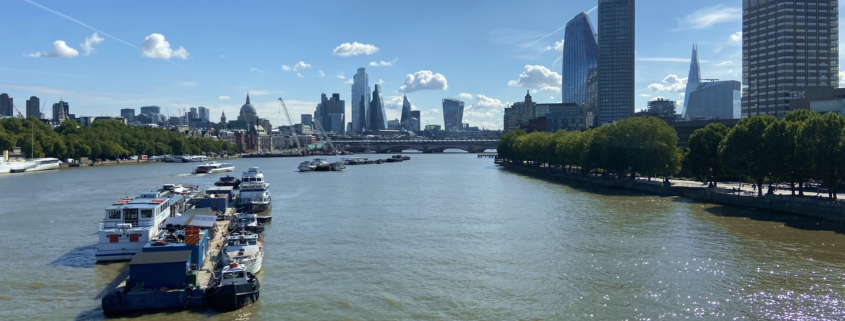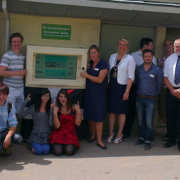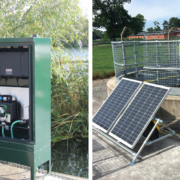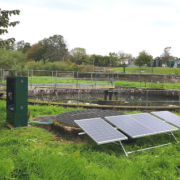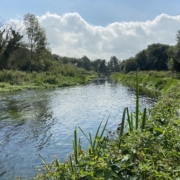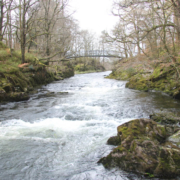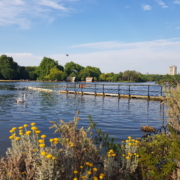How do you monitor water quality in a tidal river?
If water samples are taken from a river at 9am on consecutive days, it is reasonable to be able to directly compare analytical results, unless the water at the sampling location is tidal. This is because water quality is heavily affected by the state of the tide, which presents a significant monitoring challenge in the lower reaches of many rivers. To overcome this, scientists at the company Meteor Communications have developed a continuous monitoring and data management system that is able to remove the effects of tide and unveil the true underlying water quality.
The River Thames is tidal all the way up to the Teddington weir in west London, and with a tidal range of up to seven metres, this river is particularly challenging to monitor. Over the last 20 years, Meteor Communications has helped to develop modular water quality systems and advanced software programs that resolve the problems involved with monitoring a tidal river, whilst also delivering a capability to conduct continuous real-time monitoring at almost any location. In the following article, Meteor’s Managing Director Matt Dibbs explains how water quality monitoring has developed, and how this can be used to monitor recent improvements in tidal rivers such as the Thames.
The quality of water in the River Thames has been a major concern for the inhabitants of London for over 150 years. Consequently, samples have been taken for testing throughout the river’s recent history, helping to track water quality trends and identify trace pollutants. However, continuous monitoring is required where it is necessary to detect pollution incidents and effectively measure the impacts of mitigation measures. Apart from natural factors and variations, the main issues with potential to significantly affect water quality in the Thames are treated effluent discharges and sewage overflows during heavy rainfall.
Background
Rising in Gloucestershire and flowing through the Cotswolds, passing Oxford and Windsor, the River Thames meets the North Sea after passing through London. Stretching for 215 miles, the Thames is the longest river entirely in England and provides amenity value for large numbers of citizens. However, it has long been used as a source of drinking water, whilst also being the repository for sewage and wastewater. Today, wastewater is largely treated before discharge into the Thames, but during heavy rainfall wastewater overflows into the Thames, significantly affecting water quality. To address this, the Thames Tideway Tunnel (TTT) is being built to gather overflows and direct them to the Beckton Wastewater Treatment Works. Once complete, the TTT will need to be able to demonstrate improvements in water quality – monitoring systems that take account of the tide will therefore be essential.
In the past, prior to the implementation of London’s sewerage system, the effects of domestic and industrial discharges were more serious. In the 19th century, news reports described the Thames as a vast, foul-smelling drain. In the summer of 1858, water quality was so bad that the smell of the river, known as the ‘Great Stink,’ caused Parliament to leave London. Subsequently, Sir Joseph Bazalgette was contracted to design and build a sewer system. At the time of the Great Stink, London was home to just two million people, but fortunately Bazalgette had the foresight to build a sewer system for a population twice that size, and much of the system remains in good working order. However, whilst these Victorian initiatives helped to lower pollution levels, water quality remained poor into the 1960s; the combined effects of inadequately treated sewage, industrial discharges, thermal pollution from power stations and the extensive use of non-biological detergents meant that parts of the estuary were incapable of supporting common river species such as insect larvae, crustaceans and fish.
Today’s challenge
Almost 9 million people now live in the capital, so significant investment has been made in the city’s wastewater infrastructure in recent decades. However, during periods of high rainfall, the system is still unable to cope with the volume of flow, and excess wastewater overflows via combined sewer overflows (CSOs) directly into the Thames. As a result, millions of tonnes of raw sewage passes, untreated, into the River Thames each year.
Infrastructure development in London includes new commercial and residential properties, as well as car parks, roads and paths. These hard, non-porous areas increase the speed with which rainfall enters the drainage system; thereby exacerbating the problem. However, sustainable urban drainage systems (SUDS) now feature in many new developments and these initiatives help to slow the flow. In addition, local authorities are increasingly looking to utilise natural flood management tools to help cope with high precipitation events rather than building infrastructure which transfers the problem elsewhere (downstream). Much of the bankside in London is concrete or metal, which drastically reduces the habitat for many riverine species, so developers are now being encouraged to create green wetland areas which enhance biodiversity and create a more attractive view for valuable bankside properties.
In addition to the challenges posed by urban development, climate change is increasing the urgency with which urban drainage and wastewater treatment issues must be addressed. Climate predictions indicate that London is likely to experience more extreme weather events, so drainage and wastewater infrastructure must be designed to meet these growing challenges.
The River Thames and its major tributaries are the primary water resources in a total catchment serving a population of over 12 million people. There are over 3000 licensed abstractions of water, accounting for approximately 55% of effective precipitation. In addition there are over 10,000 consents to discharge sewage or trade effluent into the catchment. This means that, in terms of rainfall versus abstraction, the Thames is the most heavily used river in Britain.
Thames Tideway Scheme
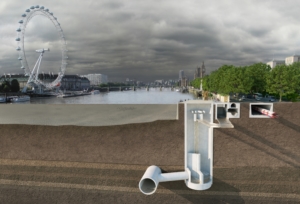
Visualisation: Victoria Embankment
The three key components are collectively known as the London Tideway Improvements. They are:
- The construction of a deep storage and conveyance (4.3 miles) tunnel from the Abbey Mills Pumping Station near Stratford to Beckton Sewage Treatment Works. The Lee Tunnel was opened in January 2016 and captures 16 million tonnes annually from the single largest CSO in London. This is allowing the tidal River Lee (a tributary of the Thames) to regenerate.
- The second component of the scheme has upgraded and extended London’s five major sewage treatment works. This is enabling them to treat greater volumes of sewage, which reduces the need for CSO discharges.
- The 25 km Thames Tideway Tunnel is being constructed between Acton in west London, travelling through London at depths of 30 to 60 metres, using gravity to transfer waste eastwards. The tunnel closely follows the route of the river, intercepting targeted CSOs that currently discharge an average of 39Mm3 of untreated sewage per year. Once complete, it will connect to the Lee Tunnel and sewage will be pumped to the Beckton Sewage Treatment Works by the Tideway Pumping Station. The TTT is so large that it is the width of three double-decker buses side by side; consequently, in addition to providing interception to CSOs, it will also offer substantially increased storage capacity during peak flows.
One of the key objectives of the TTT, in combination with the improvements to the five sewage treatment works, will be to control discharges and improve river water quality.
Water quality monitoring
Sampling for laboratory analysis provides an opportunity to analyse a wide variety of parameters including the priority substances identified by the EU Water Framework Directive. Continuous monitoring, however, fulfils a different purpose; providing a continuous data stream for key indicative parameters such as pH, conductivity, turbidity, dissolved oxygen, ammonium, Blue Green Algae and chlorophyll. This enables the detection of sudden changes that arise from pollution incidents; helping to raise timely alarms and identify the source of pollution.
One of the most important benefits of an integrated system that monitors an entire catchment is the ability to track pollution events as they move with the river, so that water treatment plants can adjust their intakes accordingly. In addition, by monitoring all day every day, Meteor’s scientists are able to accommodate the significant effects of tidal water with software known as ‘Half Tide Correction’ (HTC).
Meteor’s HTC software creates zones in the river which are defined by their distance from a fixed point, such as a bridge. This enables the continuous monitoring of water quality in each zone, wherever it is in the ebb and flow of the tide. As a result, water quality issues can be detected very quickly, which means that timely mitigation measures can be deployed – emergency water oxygenation for example.
In the river Thames the worst water quality issues typically occur when sudden high levels of rainfall follow a dry period. This is because waste materials accumulate and concentrate during dry periods and when stormwater rushes into the drainage system, the leading edge of the flow is generally the most polluted, and it is this issue that the TTT is targeted to address. Nevertheless, it is possible that CSOs will still discharge into the Thames after the Tunnel is opened (in 2025), but the Thames Tideway Tunnel Scheme will ensure that around 95% of CSO discharges are diverted for treatment.
High intensity monitoring
In the UK, the decline of manufacturing, coupled with investments and improvements in wastewater treatment systems have contributed to an overall improvement in Thames river water quality. However, storm overflows typically initiate sudden sags in dissolved oxygen – often in conjunction with a rise in ammonium. The speed with which such changes can occur necessitates (almost continuous) high intensity monitoring.
Over the last 20 years Meteor Communications has developed and refined its range of ESNET (Environmental Sensor NETwork) continuous water quality monitoring systems, so that they can be quickly and easily deployed at almost any location; delivering data via telemetry within minutes of installation. 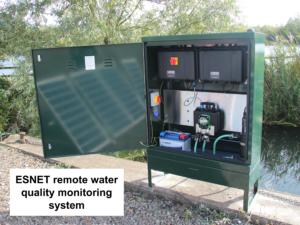 The systems are available in a kiosk for semi-permanent installations or as a portable unit for temporary monitoring projects or investigations. Each system is built around a battery-powered multiparameter water quality sonde which takes readings at 15 minute intervals (although faster measurements are possible). Data are then transferred by 3G/4G to a central database.
The systems are available in a kiosk for semi-permanent installations or as a portable unit for temporary monitoring projects or investigations. Each system is built around a battery-powered multiparameter water quality sonde which takes readings at 15 minute intervals (although faster measurements are possible). Data are then transferred by 3G/4G to a central database.
Modularity is a vitally important feature of the ESNET systems. For example, the core components of a kiosk system are exactly the same as a portable system. This means that, for example, a kiosk system can be converted into a portable system within seconds, and sondes can be swapped without harming data accuracy or integrity.
To support the 500+ ESNET monitoring systems that are currently in operation on rivers and at treatment works across the UK, Meteor Communications has established a dedicated Water Quality Services Hub near Basingstoke. The company’s ‘Water Quality as a Service’ operation is handled by this facility. Under this scheme, customers do not own the monitors; they simply pay for access to their own water quality data. Meteor installs and operates the ESNET systems and the sondes are exchanged on a monthly basis, after which each sonde is returned to the Basingstoke laboratory where it is serviced and calibrated before redeployment.
Summary
Historically, many societies have treated rivers as drains; providing a vehicle for the removal of waste and flood water, but today the real environmental and amenity value of rivers is better appreciated, and the Thames Tideway Tunnel Scheme is a good example of the work that is being undertaken to improve the quality of UK rivers. Continuous monitoring performs a vital role in all such initiatives.
Over the last 20 years, a number of factors have combined to enable the implementation of highly effective water quality monitoring. Sensor technology improvements have meant that readings do not drift and the periods between calibrations have been extended to enable long-term deployment. The latest communications technologies make it possible to gather data from almost anywhere, and to communicate with remote installations at low cost.
Over the years, monitoring system hardware has been improved so that it is compact, rugged, self-contained and modular. As a result, ESNET systems can be deployed quickly and easily; delivering data within minutes of deployment.
There are many advantages to be gained from monitoring networks as opposed to single monitors. For example, with larger numbers of sensors, it is possible to identify and reduce areas of data uncertainty. In the future, it may also be possible for algorithms to be created that reduce the requirement for manual calibration.
Monitoring networks enable the tracking of pollution and help to identify the sources of pollution. This information can be used to develop better informed interventions and to help farmers and other landowners adopt practices that improve water quality.
With the benefit of the HTC module, monitoring systems are able to assess the effectiveness of the measures contained within projects such as the Thames Tideway Scheme, so that the value of investments can be qualified; thereby informing decisions on future developments. Looking forward, it is inevitable that more high-intensity monitoring systems will be established as the world’s great conurbations develop into smart cities.

